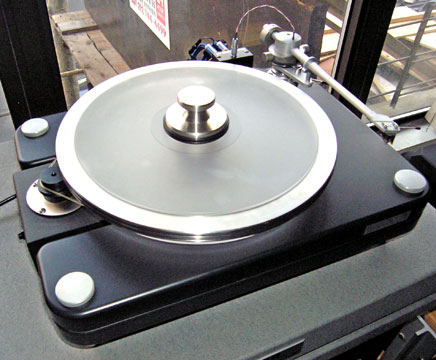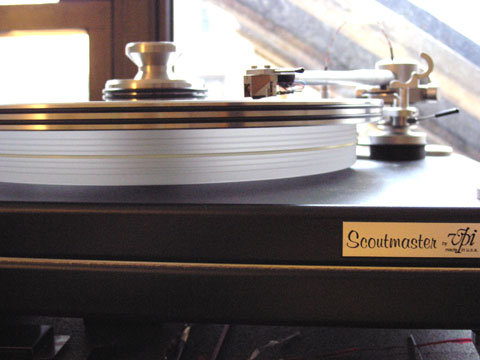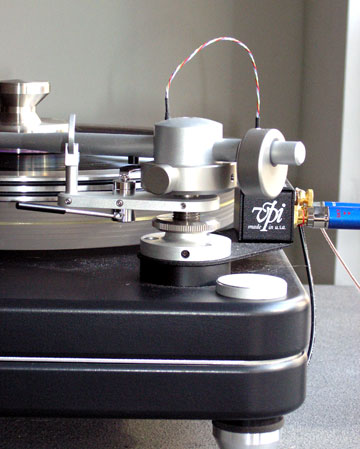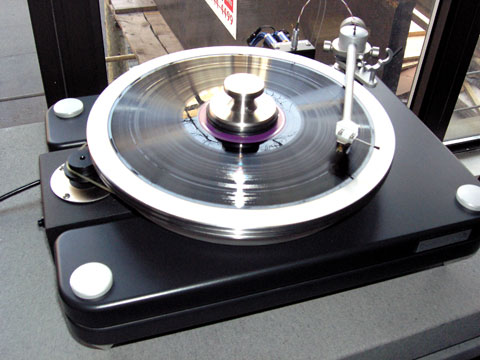You are reading the older HTML site
Positive Feedback ISSUE
17
january/february 2005
vpi
Scoutmaster turntable
as reviewed by Myles Astor

Photos by Myles Astor; image processing by Robinson
|
MYLES B. ASTOR'S SYSTEM
LOUDSPEAKERS
ELECTRONICS
SOURCES
CABLES
ACCESSORIES
|
In The Near Corner, Tipping the Scale at 48 Pounds and Hailing from the Great Garden State….
Is anyone really shocked by the continuing improvement and success of analog playback equipment? (Or as Robert Klein said, "If I wasn't trained for surprises, I'd be surprised.") The only surprising fact? Just how large a gulf still exists between the sound of analog and digital components, given the massive capital outlay by the digital manufacturers. To my ears, there's no arguing that a properly designed and set-up analog front-end is more faithful to the sound of live music in every way that matters, than digital.
Progress sometimes comes about in unexpected ways. In the case of VPI, the new Scoutmaster was born of the effort by designer Harry Weisfeld to produce a reasonably priced table/arm package. To bring the 'table in at a $2400 price point, Weisfeld needed to reduce manufacturing costs through simplying the table and arm's construction. The result? VPI's Scoutmaster turntable is in every way, shape and form, simply a stunning accomplishment. Don't be fooled by the 'table's diminutive 19 x 14-inch footprint. Don't be fooled by its lack of bells and whistles. Don't be fooled by its price. This muscular and compact 48 lb. package is a heavyweight contender in every sense of the word. The Scoutmaster could be the ultimate—and even last turntable—for many analog music lovers.
Let's Get Ready to Rumble
Many reviews would take a reductionist (or bottoms-up) approach to understanding why the $2400 stripped down or $3900 totally tricked out Scoutmaster turntable bears comparison to a large cast (including VPI's own 'tables) of considerably higher priced high-end 'tables. Sure, there are the usual suspects: macro and micro-speed stability; vibration isolation; preventing motor noise from reaching the platter; and build quality, among many factors. Scientists and philosophers among us realize, though, that dissecting this 'table into its fundamental elements won't do the Scoutmaster justice; there are often unpredictable synergies created among the various basic elements that contribute to the product's sound. That goes double when it comes to a product like the Scoutmaster, where the whole is greater than the sum of the parts.
There are, however, two factors contributing to the Scoutmaster's sonic signature that merit further exploration. First is the choice of platter material. Several years ago, Harry Weisfeld lent me an acrylic platter to experiment with on my TNT VI-HR/12.5 table combination. Substituting the acrylic for methacrylate platter totally transformed the 'tables' sonic signature. Previous generations of VPI 'tables based around the methacrylate platter were characterized by a highly musical but mellow, rounded and slightly opaque sound, exceptional soundstaging and extended low frequencies. If anything, the VPIs were slightly forgiving. The TNT VI-HR with acrylic platter was far more transparent, livelier and capable of greater low-level resolution and upper octave extension.
All was not quite right. The low-end extension of the acrylic platter (and maybe true also for the Scoutmaster to a lesser extent) mounted on the TNT didn't match the methacrylate. My first thought was here's another mutually exclusive, high-end audio tradeoff. Little did I know at the time that Weisfeld was hard at work on another turntable design based around the acrylic platter.
Next, and just as important an addition to the VPI Scoutmaster, is the record clamping system. Consisting of a periphery clamping ring and metal record clamp, the 7-pound, stainless steel ring fits snugly over the edge of the record and record platter, and in concert with the 1.6-pound metal record clamp, firmly presses the LP against the platter. (Do use the ring with the metal record clamp, not the stock plastic clamp!) So how does solidly clamping the LP to the platter translate into better sound? Students of the analog art realize the importance of holding the cartridge motionless above the record groove. Any extraneous movement, whether it's traceable to record warps (having their greatest affect at the outside edge of the LP), vibrations, loose or poorly constructed tonearm bearings, prevent the stylus from accurately retrieving the tiniest bits of information embedded in those record grooves.
Unwanted cartridge motion also affects sonics in unique ways. According to Weisfeld (and this can be verified using an oscilloscope), low frequency cartridge movement can sap an amplifier's power. So it's no surprise that many people report that clamping results in greater system dynamics.
Now keeping that cartridge platform stable while playing an LP is far easier said than done. Enter the Scoutmaster's peripheral clamping ring and clamp. While not exactly a new concept, this clamping system elevates the Scoutmaster turntable to a true heavyweight division contender. Transparency is dramatically improved. Instruments are more focused and three-dimensional. Macrodynamics hook you. Most of all, the 'table's noise floor hits the canvas.
Yet, there was a chink in the table's armor. No matter what LP was spun, the microdynamics, otherwise known to musicians as dynamic accents, were not right. The music was just a touch too laid back. Was this another case of ridding some colorations and producing an overdamped sound? Could readjusting the cartridge's VTA restore the missing microdynamics? After all, it's very easy to use VTA as a tone control. First, the VTA was dropped with no luck. Next, the VTA was raised. Bingo! The missing microdynamics were restored.
As more and more records hit the Scoutmaster's platter, it became clear that the Scoutmaster's sense of liveliness, the precision at which notes are rendered (a combination of the initial attack and internote silence), the lowered noise floor and resultant transparency, are in large part traceable to the new platter material and clamping system. Gone is the traditional VPI sound; in its stead is a far more neutral and accurate sound (in the positive sense), particularly from the upper bass through the upper frequencies. No better example exists in my record library of this sonic change than a little known gem entitled The Art of the Koto (Elektra EKS-7234) and featuring renowned Japanese koto player Kimio Eto. The koto possesses a dexterity, agility, deftness lacking when played back via the TNT. Notes start and stop on a dime; at the same time, the instrument is awash in reverberant sound field. Take special note when Eto slides his hands to the texture of the strings.
The Gloves Come Off
It's certainly more informative in the case of the Scoutmaster, however, to take the top-down approach to reviewing the Scoutmaster. Here, without question, the sound of the 'table is greater than the sum of the parts.
As I said in Positive Feedback Online's "2004 Writers' Choice Product of the Year" nominations, the Scoutmaster just exudes resolution and transparency. The Scoutmaster allows the listener to peer into the deepest recesses, into the corners of the stage, especially on orchestral music. None of that would have been possible without the able assistance of the accompanying components, including AudioQuest's top-of-the-line Everest speaker and Sky interconnect cables (that received a undeservedly bad rap in a recent review), conrad-johnson's newest spell casting Premier 140 amplifiers and the M-L Prodigy speakers—which just sound better and better with every upstream improvement.
The 'table is resolving to a fault. (In contrast to old days, this increased resolution won't force the listener to play only audiophile approved LPs) Every record, every A- and B-side, every track, every solo, sounds remarkably different. It's obvious when some tracks are recorded at different times, in different studios, with different mikes, etc. As I intimated in my PFO 2004 Product of Year selection, the Scoutmaster is so resolving that classical music lovers will give pause to reevaluate the sonic ranking of the all-time best record labels and records. While RCAs Living Stereo and Mercury's Living Presence series have captured many an audiophile's attention, the Scoutmaster helps the Deccas from the other side of the big pond get the judge's nod.
I know the esteemed Sid Marks will point to RCA's glorious string sound and natural hall perspective, but through the new Scoutmaster, the Living Stereos are no match for the best recordings from the Decca catalog such as Verdi's Four Sacred Pieces (Decca Set 464), Mahler's Symphony No. 3 (Decca Set 385-6), Britten's Cantata Misericordium (Decca SXL 6175), or Resphigi's Feste Romane (Decca SXL 6822).
For some hard hitting action, try on Varese's Integrales and Ionisation (Decca SXL 6550) for size. Here the Decca recording team bested the best their American colleagues could offer: an ability to capture a limitless sense of hall acoustical space and realistic hall perspective. The 'table's transparency gives the same degree of illumination to instruments residing on the front and back of the stage. Drums on the Varese have the low-end, and percussion, the upper octave extension that the RCAs never had. But, the Varese also shows that lower octave extension is one area that the Scoutmaster falls short of ideal. Here, the 'table doesn't quite maintain the purity of the sound, extension or dynamics found elsewhere in the musical spectrum. Also, there's also probably even more acoustical information present on the disc. This is probably the result of several things, most notably some of the compromises inherent in the design of the 9-inch arm.
What really separates the Scoutmaster plus clamp from other 'tables is how faithfully it recreates that elusive sense of space between the edge of the orchestra and the side-walls of the hall on the Varese. With many 'tables, including my old TNT, the soundstage ends with the last instrument, creating an incongruity between the orchestra and the shell of the hall. Because of the 'table's low noise floor and lack of grunge, this intervening space is now revealed and adds to the reality of the recording and sense of spaciousness. Hall boundaries, reflections, all indicative of greater low-level resolution, just seem to have a greater sense of solidity and depth. The feeling is akin to the difference between a wood shaving and a solid ¾-inch piece of oak.
Give 'em the Old One-Two!
The second label flying beneath most audiophile's analog radar screen is Nonesuch's American Music series. Produced by the late Teresa Sterne and the recording team of Mark Aubort and late Joanna Nickrenz, these are very special recordings. Aubort and Nickrenz were pioneers in high-end recording techniques: minimal miking, tube microphones and 30-ips tape machines. There's rarely a clunker among them (assuming one's musical taste includes modern American composers). Among my favorites are Stefan Wolpe's Quartet for trumpet, tenor saxophone, percussion and piano (Nonesuch 71302) and Percussion Music (Nonesuch 71291).
The Nonesuchs are to some extent the sonic opposite of the RCA and Mercurys. While not quite as rich as the RCAs, the Nonesuch's are free of many of the frequency limitations and colorations of the earlier pioneering stereo releases. Compared the RCAs and Mercurys, and to a lesser extent the Deccas, the Nonesuch recordings also possess an amazing sense of transparency and hall acoustics. Played back through the Scoutmaster, listeners can hear the Nonesuch's extended upper octaves. On the Wolpe, the trumpet is full and brassy without any accompanying brightness, spittiness, or distortion. Take for instance the tenor sax. Most 'tables either thin this instrument out or overly romanticize it. Not with the Scoutmaster. Here, the 'table's neutrality comes across shines in its reproduction of sax's reedy quality.
Delivering the Knockout Blow
No single record label has a monopoly on good sound. One hidden gem from the Musical Heritage Society catalog is the recording Songs from the Fayrfax Manuscripts (MHS 4649) featuring Edgar Fleet and the Pro Cantione Antiqua. This 1982 Tony Faulkner recording, and one of his all-time best efforts, sets the gold standard for capturing the realism of a live, early music performance. Because of the Scoutmaster's low noise floor and lack of grunge, it's easy to appreciate the careful balance struck between the reflected and the direct sound. One is seated in the fourth row at the concert (that happens to be my favorite seat, given the scale of early music). The wide range of both male (countertenor and bass) and female voices (soprano) is faithfully captured and reproduced by the Scoutmaster. One can easily close their eyes and imagine a three dimensional palpable body behind each voice—yet hear the wonderful limitless church acoustics. About the only down-side to this recording is the typical MHS-quality vinyl that limits the recording's transparency.
The Scoutmaster's exceptional transparency is sometimes a double-edged sword. Specifically, choose your record cleaning fluid carefully. Almost 15 years have elapsed since my record cleaning fluid survey appeared (Sounds Like…, No. 8, May 1990), but the message remains the same. What cleaning fluids leave behind is just as important as how well they clean! Skipping ahead to 2004, the sonic differences between fluids are even more apparent with the Scoutmaster. Though by no means an exhaustive survey, I did compare RRL's Super Vinyl Wash to Nitty Gritty's Pure 2. The Nitty Gritty definitely colored the sound. Upper octaves were attenuated, transparency was reduced; as one progressed to the rear of the hall, images were unfocussed. (And yes, I tried adjusting VTA). On the other hand, the RRL didn't seem to have any negative effects on the sound and only improved the records' sonics.
The Referee's Announcement
Your attention please! The winner by knockout in the first round and still undisputed, heavyweight champion: analog!
Another winner, this one by sonic knockout, is VPI's Scoutmaster turntable. The newest effort from VPI designer Harry Weisfeld brings the listener ever closer to the elusive goal of recreating the master tape's dynamics, neutrality, soundstaging and imaging. Where the Scoutmaster really breaks new ground is in its neutrality. Not only does one hear the aforementioned master tape qualities, but the dramatic differences between recordings. For the first time, I really appreciate exactly what many of the leading recording engineers and labels were trying to accomplish with their different microphoning techniques.
Tech Talk
The Scoutmaster covered in this review consisted of the basic 'table and 9-inch arm package, the latest 300-rpm motor plus the SDS (Synchronous drive system) motor drive and platter periphery clamping ring and metal record clamp. Lyra's Parnassus DCt moving coil cartridge traced the record grooves. (One hasn't heard this cartridge until it's been mounted in the VPI 9 or 12-inch arms). The 'table resided atop a Silent Running Audio platform that was placed on a Sound Anchors equipment stand.
The simplicity in design carries over to 'table assembly. There's no suspension to adjust. All the owner needs to do is position the 'table on a level turntable stand, install the platter and arm, adjust the turntable speed and mount the cartridge. Setting the 'table up was roughly a 10-minute job; installing the cartridge (luckily, I still have an old AT cartridge analyzer to align the cartridge) is no more than a 20-minute job. So, most dedicated analog people should have the 'table up and playing tunes in around 30 or so minutes.
Turntable Plinth

There's nothing particularly exotic here other than solid construction. The plinth consists of a bottom 1¼-inch piece of MDF, a middle 11 gauge piece of stainless steel and a second 1¼-inch pieces of MDF. The three pieces are bonded together using GE Silicone sealant. The plinth rests on four tiptoes with 60 Rockwell hardness balls set into bottom of each cone. A rubber washer sits between the cones and the plinth to allow for turntable leveling. Word of warning! Don't use the feet for leveling except under extraordinary circumstances! Otherwise, transparency, low level resolution and three-dimensional instrumental solidity are compromised.
Platter and Bearing Assembly
LPs rotate on a 10-pound "VPI HR-X-type," 1¾-inch, all acrylic platter. The periphery clamping ring weighs in at 7 pounds, and the center metal record clamp adds another 1.6-pounds (the first time I recall this sort of clamping arrangement was the old Kenwood 'table that populated a few high end systems about the time I first became involved in high-end audio in 1976), bringing the grand to 18.6-pounds; according to Weisfeld, this gives the combination the inertia of a 31 pound acrylic platter (without some of the associated drawbacks).
How the turntable designer deals with energy generated at the stylus/LP interface has profound implications on the turntable's sound. (Think of what happens when light passes through material with different refractive indices.) In the case of the turntable platter, there's the mechanical effect of absorption, reflection and transmission of energy from stylus/groove interface. For instance, out-of-phase, reflected energy can among other things, decrease dynamic range. Acrylic, as opposed to methacrylate platters, are lower density and consequently less prone to energy storage
In contrast to older VPI designs, the Scoutmaster's platter sits atop an inverted bearing assembly. This bearing design was primarily selected on the basis of its simplicity and lower cost; its resultant sound was side benefit. For the non-technical analog lovers, the advantage of the inverted bearing is that belt pulls through the center bearing assembly and doesn't cause a sideways pull on the platter. The bearing uses a 60 Rockwell hardness ball in bronze/delrin bushing for greater quietness.
A 300-rpm motor specifically selected for its 3Hz resonance point drives the acrylic platter. This places the motor's resonant point far below the cartridge/arm resonance response. The newest version of the Scoutmaster uses a black, one piece belt.
JMW-9 Arm

Relatively speaking, the arm is probably the weak point of the Scoutmaster combo. (Remember, the 'table was built to a price point.) That's not to say the arm is poorly designed. All it means is that the 9-inch arm suffers from a geometrical compromise, and several others, compared to the longer and more expensive VPI arms. One area this really shows up is in the opening track of an LP (yes, the outside of the LP is one area where warps make their presence most known—but it's more than this). Now here's another example where the combo's resolution is a double edged sword. The 'table is so resolving that the listener can not help but notice the change in sound as the cartridge approaches the optimal tangency point on the LP—especially if one is used to listening to well-designed linear tracking arms or the longer 12-inch VPI arm. The most noticeable sonic effects one hears as the cartridge begins to approach optimal tangency are increased ambient resolution and instrumental focus, and low-frequency weight.
The 9-inch Aluminum arm is internally damped with a crazy-glue like compound. Like previous VPI arms, there is no provision for setting antiskating since Weisfeld feels antiskating settings are at best a compromise. Unlike most unipivot designs, VPI's 9-inch arm does not use damping fluid. Basically, damping is used to prevent extraneous arm motion. Damping, unfortunately, is not without is drawbacks, including an overly smooth and rolled off sound. Since the Scoutmaster bearing basically doesn't have any vertical motion, damping is rendered unnecessary according to Harry Weisfeld, and the top-end response of the arm opens up.
The unipivot bearing is fashioned from extremely hard tungsten carbide; this material will shatter but won't break. Because of the unipivot design, the arm wand is easily replaced, and an owner can, if desired, have different cartridges mounted in different wands. Also, because there's no damping fluid necessary, the arm, in contrast to the older damping VPI arms, is truly interchangeable.
Like all VPI arms, VTA adjustment is relatively easy to adjust even while the turntable is playing. After settling on the correct VTA, the arm can be locked down via two screws, one located on the arms side and one to the rear, to ensure maximal arm rigidity. With the 9-inch arm, 16 turns equals 1 inch (or 0.0625-inches per turn). I do wish that VPI had added a directional arrow to show which way to turn the knob to raise or lower the arm. Maybe it's premature senility setting in, but I always forget which way to turn to adjust the height. In addition, it would be nice if the knob had some notches on the side so one can have a frame of reference for reproducibly adjusting VTA.
The arm's mass allows it to work optimally with cartridges weighing between 9 to 12 grams. Thus the 9-inch arm makes an excellent platform for the world's leading cartridges, such as the Lyras, Clearaudios, Benzs and Dynavectors.
There was one area—namely setting the VPI arm's azimuth and vertical tracking force—which left me cold. Like the Wilson-Benesch arm I had the opportunity to play with years ago, you slide the counterweight back and forth to set VTF, and rotate the counterweight around the arm's axis to set azimuth. Consequently, it's extremely difficult to adjust VTF without changing azimuth and vice versa.
One final, though annoying nitpick with the 9-inch arm (and other VPI arms), is misalignment of the arm rest assembly. The arm rest never seems to be set so the arm can be picked up at the end of the record. Luckily, the fix is easy using the Allen screwdriver provided: loosen the set screw located on the side of the arm rest and then rotate the assembly so the arm can be picked up at the end of the record.
Record Clamping System

The ring generally works as advertised; I did manage to find two LPs that didn't work with the clamp. In addition, most records were flattened and made good contact with the platter; there were a few difficult warps that even this clamping (or probably any system) didn't help. A word of caution when using this clamping system: keep the platter meticulously clean; otherwise, dirt trapped between the platter and LP could be pressed into the record grooves leading to increased surface noise.
Before receiving the clamping ring, I was convinced that the Scoutmaster upgrade route entailed first adding the SDS (synchronous drive system), then the clamping ring. For those not familiar with the SDS, its role is to provide greater speed stability by reducing microspeed fluctuation. After receiving the ring and listening, my mind changed. Clearly, the clamping ring is the accessory (really a necessity) that should be first in line. The ring, by virtue of increasing platter inertia, smoothes out speed fluctuations. Myles B. Astor
Drive system: 300-rpm AC synchronous motor with belt
drive
Tonearm: 9-inch, undamped, VTA adjustable, unipivot
Turntable dimensions (w x d): 19 x 14 inches
Weight: 48 pounds
VPI Scoutmaster Turntable
Retail: $2400 with 9-inch arm; add $1000 for SDS;
add $500 for periphery ring clamp
VPI Industries
77 Cliffwood Ave
Cliffwood, NJ. 07721
Telephone: (732) 946-8606
web addess:
www.vpiindustries.com
